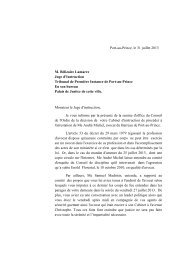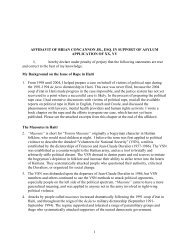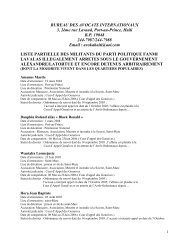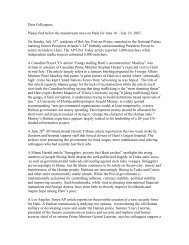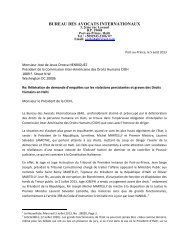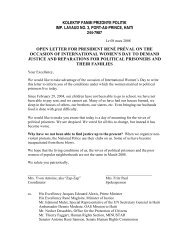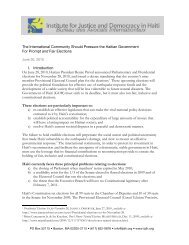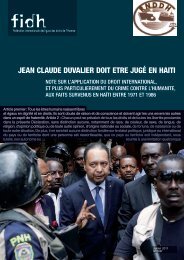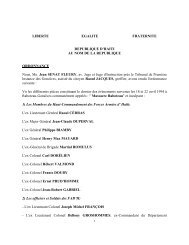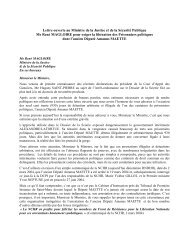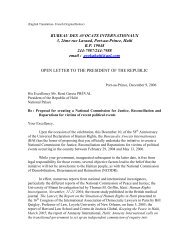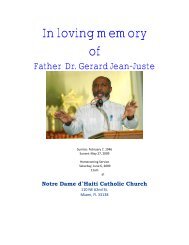Peacekeeping without Accountability - Yale Law School
Peacekeeping without Accountability - Yale Law School
Peacekeeping without Accountability - Yale Law School
- No tags were found...
You also want an ePaper? Increase the reach of your titles
YUMPU automatically turns print PDFs into web optimized ePapers that Google loves.
issues, including peace and political stability, there-establishment of the rule of law, the protectionof human rights, and social and economicdevelopment. 5 MINUSTAH’s scope and operationshave expanded since 2004, and the longstandingpresence and activity of the mission have been metwith local criticism.MINUSTAH’s administration and fundinginvolve many players. In Resolution 1542, theSecurity Council supported the establishment ofthe Core Group, comprising representatives of theOrganization of American States, the CaribbeanCommunity and Common Market, internationalfinancial institutions, and other interestedstakeholders. 6 The Core Group’s purpose is tofacilitate the implementation of MINUSTAH’smandate and states enhance the effectiveness ofthe role of the international community in Haiti.Several countries, including Argentina, Brazil,Canada, Chile, France, Peru, and the United States,have assumed lead roles in MINUSTAH’s operationsin Haiti pursuant to Resolution 1542. 7Since its establishment, MINUSTAH has been amultidimensional peacekeeping mission uniquelyaimed at addressing a broad range of concerns. 8Whereas U.N. peacekeeping operations are generallydeployed in support of a peace agreement reachedbetween parties to a conflict, MINUSTAH wasdeployed <strong>without</strong> such an agreement or ongoingconflict. 9 Instead, MINUSTAH was established inresponse to a complicated and sometimes violentpolitical struggle among different factions in Haiti.In 2000, President Jean-Bertrand Aristide was votedinto office during an election contested by politicalopponents and some members of the internationalcommunity. 10 In February 2004, former soldierstraining in the Dominican Republic invaded Haitiand took large areas of the country. PresidentAristide left Haiti on a plane controlled by the U.S.government. The U.S. government claimed thatPresident Aristide left willingly; President Aristideclaimed he was forced onto the plane. BonifaceAlexandre, then President of the Supreme Court,was sworn in as Interim President. 11 Mr. Alexandrerequested assistance from the United Nations instabilizing the country in the aftermath of theinsurrection, a request that eventually led to theestablishment of MINUSTAH. 12The complicated politics of MINUSTAH’sorigins are reflected in the mission’s broadmandate. The terms of MINUSTAH’s missionhave been defined by a series of Security CouncilResolutions establishing and renewing theMINUSTAH mandate. MINUSTAH’s originalmandate, set forth in Security Council Resolution1542, established three main mission goals: toensure a secure and stable environment, to supportthe conditions for democratic governance andinstitutional development, and to support thepromotion and development of human rights. 13In the same resolution, the Security Councilprovided that MINUSTAH “shall cooperate with theTransitional Government [of Haiti] as well as withtheir international partners, in order to facilitatethe provision and coordination of humanitarianassistance.” 14 Subsequent resolutions between 2005and 2009 renewed and provided minor adjustmentsto the original MINUSTAH mandate. 15MINUSTAH’s mission structure and operationsreflect the breadth of its mandate. The original 2004mission plan envisioned three main components:a military force to establish a secure and stableenvironment throughout the country, a civilianaffairs component responsible for overseeing acivilian police force and supporting initiatives tostrengthen local governmental and civil societyinstitutions, and a humanitarian affairs anddevelopment component. 16 The humanitarianaffairs and development office was tasked withcoordinating humanitarian aid among differentnational and international actors. Senior officersof all three components reported to the head ofmission, the U.N. Special Representative of theSecretary-General. 17 Additionally, the mission as awhole received support from the U.N. Secretariat’sDepartment of <strong>Peacekeeping</strong> Operations. 18 While thespecific structure of the different components haschanged since 2004, the basic organization remains. 19On January 12, 2010, a 7.0-magnitudeearthquake struck Haiti, killing over 200,000,destroying much of the capital, and strainingthe country’s already fragile social and politicalorder. 20 In response to the earthquake, the SecurityCouncil passed Resolutions 1908 and 1927, raisingMINUSTAH’s in-country troop levels and adjustingthe MINUSTAH mandate to include assisting9 minustah and the cholera outbreak in haiti



